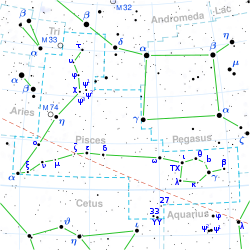33 Piscium is a binary star system in the zodiac constellation of Pisces. It is visible to the naked eye with an apparent visual magnitude of 4.61.[2] The distance to this system, as determined from an annual parallax shift of 25.32±0.53 mas,[1] is about 129 light years. It is moving closer to the Sun with a heliocentric radial velocity of −6.6 km/s.[4]
This system was found to have a variable radial velocity by Leah Allen and Adelaide Hobe of Lick Observatory in 1911.[10] It was identified as a single-lined spectroscopic binary, and the orbital elements were published by Canadian astronomer W. E. Harper in 1926.[3] The pair have an orbital period of 72.93 days and an eccentricity of 0.27.[6] This is a RS Canum Venaticorum variable,[3] indicating a close binary system with active star spots, and has the variable star designation BC Psc.[11]
The primary, component A, is a first-ascent red giant with a stellar classification of K0 IIIb, having chemical abundances that match a first dredge-up mixing model. Pourbaix & Boffin (2003) estimated the mass of the primary as 1.7±0.4 M☉ and the secondary as 0.76±0.11 M☉.[3] However, Feuillet et al. (2016) derived a much lower mass estimate of 0.83±0.22 M☉ for the primary.[7] At the age of roughly five[7] billion years, the star has expanded to 7 times the radius of the Sun.[8] It is radiating 24[8] times the Sun's luminosity from its photosphere at an effective temperature of about 4,736 K.[7]
- ^ a b c d e f Cite error: The named reference
vanLeeuwen2007was invoked but never defined (see the help page). - ^ a b c d e f g h i Cite error: The named reference
Ducati2002was invoked but never defined (see the help page). - ^ a b c d e Cite error: The named reference
Barisevicius2011was invoked but never defined (see the help page). - ^ a b Cite error: The named reference
deBruijne2012was invoked but never defined (see the help page). - ^ Cite error: The named reference
Anderson2012was invoked but never defined (see the help page). - ^ a b Cite error: The named reference
Harper1926was invoked but never defined (see the help page). - ^ a b c d Cite error: The named reference
Feuillet2016was invoked but never defined (see the help page). - ^ a b c d e Cite error: The named reference
Massarotti2008was invoked but never defined (see the help page). - ^ Cite error: The named reference
SIMBADwas invoked but never defined (see the help page). - ^ Cite error: The named reference
Campbell1911was invoked but never defined (see the help page). - ^ Cite error: The named reference
Kazarovets1990was invoked but never defined (see the help page).
